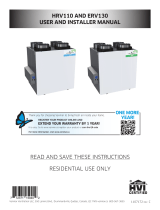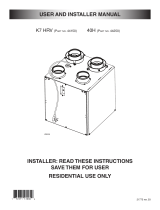
20
8. INSTALLER’S TROUBLESHOOTING
The wearing of safety glasses and gloves is recommended since a few diagnosis procedures may require the
unit to be in operation while proceeding. Be careful with moving and live parts to prevent any risk of injury.
WARNING
!
ERROR DESCRIPTION SOLUTION
E01 Supply damper range STEP 1: Unplug unit, inspect the damper system, remove any undesirable
obstacle or dirt (fi lters and core may have to be removed to access the
damper system). Plug unit.
If STEP 1 did not fi x the problem, perform STEP 2: Open electrical
compartment, check if connector J5 (white) is well inserted, check for any
loose wires.
If STEP 2 did not fi x the problem, perform STEP 3: If the damper is not
moving at all, unplug J7 (red) from the electronic assembly, connect the
white damper system connector into J7. If the damper moves (but the
system still shows an error), the electronic assembly must be replaced.
Otherwise, replace the damper system.
E02 Supply damper timeout
E03 Supply damper
E05 Exhaust damper range STEP 1: Unplug the unit, inspect the damper system, remove any undesirable
obstacle or dirt (fi lters and core may have to be removed to access the
damper system). Plug the unit.
If STEP 1 did not fi x the problem, perform STEP 2: Open electrical
compartment, check if connector J7 (red) is well inserted, check for any
loose wires.
If STEP 2 did not fi x the problem, perform STEP 3: If the damper is not
moving at all, unplug J5 (white) from the electronic assembly, connect the
white damper system connector into J5. If the damper moves (but the
system still shows an error), the electronic assembly must be replaced.
Otherwise, replace the damper system.
E06 Exhaust damper timeout
E07 Exhaust damper
E09 Recirculation damper range STEP 1: Unplug the unit, inspect the damper system, remove any undesirable
obstacle or dirt (fi lters and core may have to be removed to access the
damper system). Plug the unit.
If STEP 1 did not fi x the problem, perform STEP 2: Open electrical
compartment, check if connector J6 (blue) is well inserted, check for any
loose wires.
If STEP 2 did not fi x the problem, perform STEP 3: If the damper is not
moving at all, unplug J5 (white) from the electronic assembly, connect the
blue damper system connector into J5. If the damper moves (but the system
still shows an error), the electronic assembly must be replaced. Otherwise,
replace the damper system.
E10 Recirculation damper timeout
E11 Recirculation damper
E22 Supply airfl ow STEP 1: Unplug the unit. Perform a visual inspection of the supply damper
system. Clean fi lters, distribution registers and outside supply hood. Inspect
ducting to ensure it is not squeezed or bent. Plug the unit.
If STEP 1 did not fi x the problem, perform STEP 2: Remove ducting of the
supply path. On the LCD screen, select MAX to check if the unit is able to
reach the selected fl ow. If so, review the ducting path.
If STEP 2 did not fi x the problem, perform STEP 3: On the LCD screen, select
the MIN and MAX fl ow setting values then reset the unit. MAX fl ow value
will display on the LCD screen. If MAX fl ow is above desired MAX fl ow, set
MAX and MIN fl ows.
If STEP 3 did not fi x the problem, perform STEP 4: Replace the supply
blower and repeat STEP 3.
If STEP 4 did not fi x the problem, perform STEP 5: Replace the electronic
assembly.
E23 Supply motor (drive over current) STEP 1: Unplug/plug unit.
If STEP 1 did not fi x the problem, perform STEP 2: Remove core and clear
the ventilation wheel from any dirt or obstacles.
If STEP 2 did not fi x the problem, perform STEP 3: Disconnect J2 (white) and
connect a spare blower system. If it works, replace supply blower.
If STEP 3 did not fi x the problem, perform STEP 4: Replace the electronic
assembly.
E27 Supply motor (drive foc duration)
E28 Supply motor (drive speed feedback)
E29 Supply motor (startup)
E24 Supply motor (drive over voltage) STEP 1: Unplug/plug unit. Under and over voltage may be detected with
severe in-house power supply fl uctuation and stop the motor for protection.
If STEP 1 did not fi x the problem, perform STEP 2: Replace the electronic
assembly.
E25 Supply motor (drive under voltage)





















